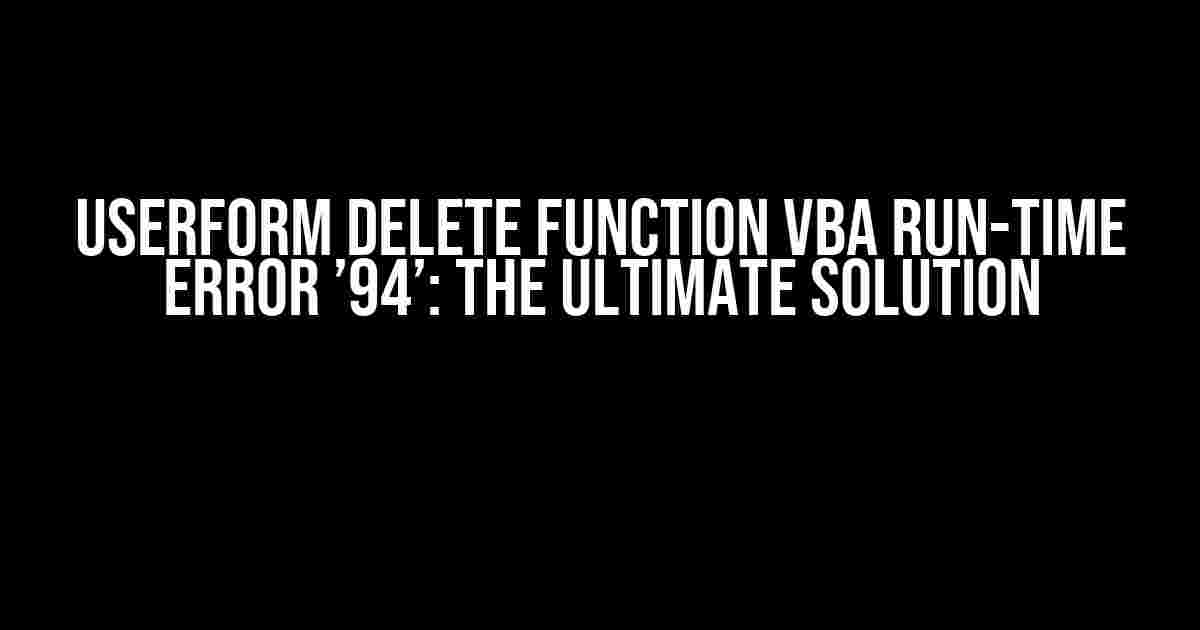Are you tired of encountering the frustrating VBA run-time error ’94’ when trying to delete a Userform in your Excel application? You’re not alone! This error can be a major hurdle in your workflow, but fear not, dear reader, for we’ve got you covered. In this comprehensive guide, we’ll delve into the world of VBA, Userforms, and error handling to provide you with a clear and concise solution to this pesky problem.
What is the Userform Delete Function VBA Run-time Error ’94’?
The VBA run-time error ’94’ occurs when you attempt to delete a Userform using the `Unload` or `Destroy` methods in your VBA code. This error typically appears with the following error message:
Error '94': Invalid use of Null
This error message can be misleading, as it doesn’t provide much insight into the root cause of the problem. But don’t worry, we’ll get to the bottom of it.
Causes of the Userform Delete Function VBA Run-time Error ’94’
There are several reasons why you might encounter this error. Here are some common causes:
- Incorrect syntax or usage of the Unload or Destroy methods: Make sure you’re using the correct syntax and that the Userform object is properly set before attempting to delete it.
- Null or uninitialized Userform object: Verify that the Userform object is not null or uninitialized before trying to delete it.
- Conflicting event handlers or code: Other event handlers or code might be interfering with the deletion process. Check for any conflicting code or event handlers that could be causing the issue.
- Corrupted or damaged Userform: In some cases, the Userform itself might be corrupted or damaged, leading to the error. Try recreating the Userform or checking for any corruption.
Solutions to the Userform Delete Function VBA Run-time Error ’94’
Now that we’ve identified the common causes, let’s dive into the solutions to fix this error. Here are some step-by-step instructions to help you resolve the issue:
Solution 1: Check the Syntax and Usage of the Unload or Destroy Methods
Review your code and ensure that you’re using the correct syntax for the `Unload` or `Destroy` methods. Here’s an example:
Unload Me
Destroy Me
Make sure to replace `Me` with the actual name of your Userform object.
Solution 2: Verify that the Userform Object is Not Null or Uninitialized
Before attempting to delete the Userform, verify that the object is not null or uninitialized. You can do this by adding a simple check:
If Not MyUserForm Is Nothing Then
Unload MyUserForm
End If
Replace `MyUserForm` with the actual name of your Userform object.
Solution 3: Check for Conflicting Event Handlers or Code
Search your code for any conflicting event handlers or code that might be interfering with the deletion process. Look for any code that might be referencing the Userform object or its components. Try commenting out or temporarily removing any suspicious code to see if it resolves the issue.
Solution 4: Recreate the Userform or Check for Corruption
If none of the above solutions work, try recreating the Userform or checking for any corruption. You can do this by:
- Deleting the Userform and recreating it from scratch.
- Checking the Userform’s properties and settings for any unusual or corrupted values.
- Trying to delete the Userform in a new, blank Excel workbook to isolate the issue.
Best Practices for Deleting Userforms in VBA
To avoid encountering the Userform delete function VBA run-time error ’94’ in the future, follow these best practices:
- Use the Unload method instead of Destroy: The `Unload` method is generally safer and more reliable than the `Destroy` method.
- Verify the Userform object before deletion: Always check that the Userform object is not null or uninitialized before attempting to delete it.
- Avoid deleting Userforms from within event handlers: Try to avoid deleting Userforms from within event handlers, as this can lead to conflicts and errors.
- Use error handling and debugging techniques: Implement error handling and debugging techniques to catch and resolve any issues that might arise during the deletion process.
Conclusion
In conclusion, the Userform delete function VBA run-time error ’94’ can be a frustrating obstacle, but by following the solutions and best practices outlined in this guide, you’ll be well-equipped to overcome this error and successfully delete Userforms in your VBA applications. Remember to stay vigilant, check your code, and test your solutions thoroughly to ensure a smooth and error-free experience.
| Solution | Description |
|---|---|
| Check syntax and usage of Unload or Destroy methods | Verify correct syntax and usage of Unload or Destroy methods |
| Verify Userform object is not null or uninitialized | Check that Userform object is properly set before deletion |
| Check for conflicting event handlers or code | Search for and resolve any conflicting code or event handlers |
| Recreate Userform or check for corruption | Delete and recreate Userform or check for corruption |
We hope this comprehensive guide has provided you with the necessary tools and knowledge to tackle the Userform delete function VBA run-time error ’94’ head-on. Happy coding!
Keywords: Userform delete function VBA run-time error ’94’, VBA, Excel, error handling, solution, fix, syntax, usage, null, uninitialized, conflicting event handlers, corruption.
Frequently Asked Question
Hey there, VBA enthusiasts! Are you tired of encountering the “Userform delete function VBA run-time error ’94′”? Don’t worry, we’ve got you covered! Here are some frequently asked questions and answers to help you troubleshoot and fix this pesky error.
What causes the “Userform delete function VBA run-time error ’94′”?
This error typically occurs when you try to delete a UserForm or its controls while it’s still loaded in memory. This can happen when you’re trying to delete a UserForm programmatically or manually. The error message “Invalid use of Null” is very cryptic, but don’t worry, we’ll help you decipher it!
How can I prevent the “Userform delete function VBA run-time error ’94′”?
To avoid this error, make sure to unload the UserForm before deleting it. You can do this by using the `Unload Me` statement in the UserForm’s code or by calling the `Unload` method from a module. This will ensure that the UserForm is fully unloaded from memory before you try to delete it.
What’s the difference between `Unload Me` and `Unload UserForm1`?
`Unload Me` is used within the UserForm’s code to unload itself, whereas `Unload UserForm1` is used in a module to unload a specific UserForm named `UserForm1`. Both methods achieve the same result, but `Unload Me` is more convenient when you’re working within the UserForm’s code.
Can I delete a UserForm control programmatically?
Yes, you can delete UserForm controls programmatically using the `Controls.Remove` method. For example, to delete a button named `CommandButton1`, you can use `UserForm1.Controls.Remove “CommandButton1″`. Just make sure to unload the UserForm before deleting its controls to avoid the run-time error ’94’.
What if I still encounter the “Userform delete function VBA run-time error ’94′” after trying the above solutions?
If you’re still experiencing issues, try to debug your code by stepping through it line by line. Check if there are any other objects or controls still referencing the UserForm or its controls. You can also try to delete the UserForm or its controls in a separate procedure to isolate the issue. If all else fails, try restarting Excel or re-creating the UserForm from scratch.


